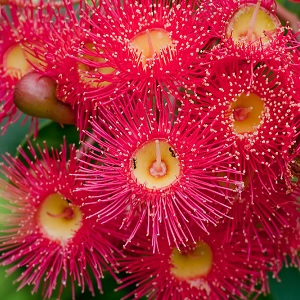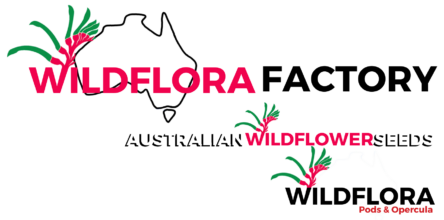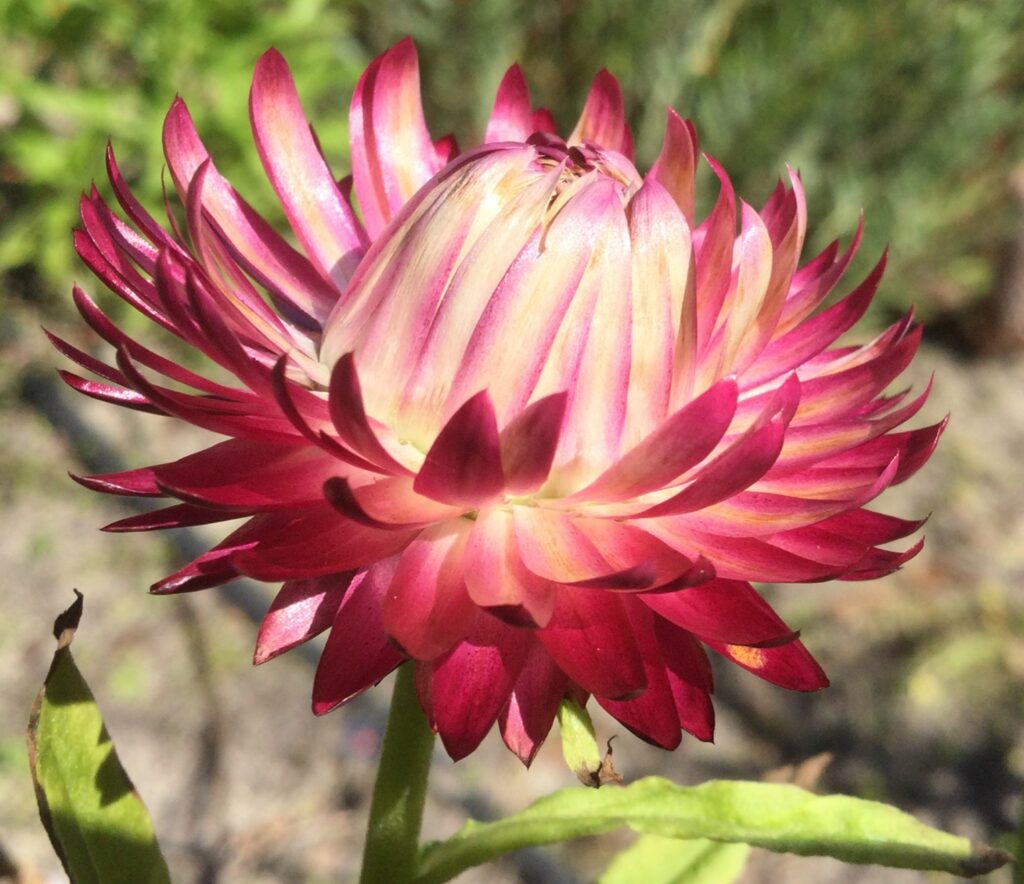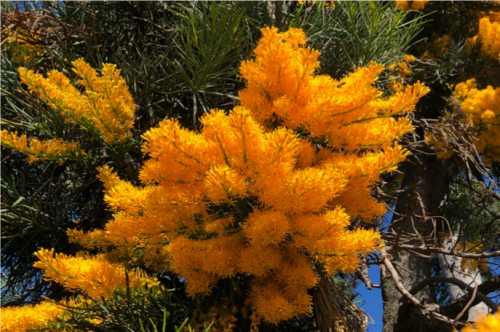Potting Mixes and Soil Needs of Eucalypts
by Kevin Handrick, September 1998
Source: http://www.hotkey.net.au/~sparrows1/sgap/sgap7a.html
Most Eucalyptus are drought tolerant and have very few pests. The eucalyptus beetle poses the greatest threat with oval-shaped holes being one of the signs of infestation. Easy to grow.
Eucalypts have evolved in Australia in an environment of increasing aridity, frequent fire and soils of generally low phosphorus status. One of the mechanisms they have evolved to cope with this is the production of extensive root systems. Another is an ability to regenerate from epicormic buds on trunks and lignotubers. Yet another is the development of mycorrhizal associations that enhance acquisition of phosphorus from soils and surface litter layers.
In many species, natural seed germination takes place mainly in ash beds after fire. Ash beds are rich in plant-available phosphorus, compared with the general soil. The soil baking associated with fire liberates soluble nitrogen in the soil. It is this enhanced availability of phosphorus and nitrogen that is a key to how we should treat seedling eucalypts in potting mixes and soils.
Potting mixes
In this part of the world potting mixes are mixtures of sand and composted pine bark. Few contain natural soil. Nutrients are provided in part by the bark, in part via additions of chemicals such as limestone, dolomite, iron sulphate and trace element mixtures, but also via controlled-release fertilisers such as Nutricote, Osmocote, Green Jacket and the like. I will discuss the relative merits of these various fertilisers below.
You can of course make your own potting mix, but most of us have come to trust the major suppliers of potting mixes in Victoria – Bio-Gro (Van Schaiks), Debco, Propine and Spotswood. These suppliers produce their mixes under strict quality control. They add the required amounts of nutrients; they adjust the pH of the mixes. They ensure that the physical property of air-filled porosity is as is needed by the types of plants for which the mix is designed.
For eucalypts being grown in tubes, the air-filled porosity of the mix (the percentage of its volume that is air space after drainage has finished) should be 10 to 15%. The pH should be in the range 5.5 to 6.4, even for those eucalypts that are lime tolerant. The mix should be easy to rewet if it dries out. This means that you should add wetting agent to it, if the manufacturer has not added some. Suitable wetting agents include Aquasoil Wetter, Nu Earth Soil Wetter, Saturaid and WettaSoil. I always add wetting agent to the mix immediately before tube filling. If you can’t get a specialist Australian Plant potting mix, your best option is to use a mix that conforms with the Australian Standard, Regular grade. Some of these have a higher air-filled porosity than is given above, so you would need to add 10-20% fine sand (by volume) to reduce it.
A Regular grade potting mix will generally have some available (soluble) phosphorus. If you know that the mix you buy does not contain some soluble phosphorus, you should add some via single superphosphate (crushed), at about 0.3 grams per litre of mix. The only eucalypts that are known to be somewhat sensitive to phosphorus are E. obliqua, E. gardneri and E. cladocalyx. The amount of phosphorus prescribed here will not harm them.
That completes your base mix. All you need to do now is decide how you will feed your eucalypt seedlings. The choice is between frequent applications of a liquid fertiliser and a once-off incorporation of a controlled-release fertiliser into the mix just before potting. For seedlings in tubes or larger containers it is easiest to incorporate a controlled-release fertiliser.
Controlled-release fertilisers
I prefer Nutricote, specifically Nutricote Blue. It contains 2.1% water-soluble phosphorus. It gives excellent results. I admit to bias to Yates, who market Nutricote. For tubes, I add it to the mix at 3.5 grams per litre of mix. The lower rate of 3 grams per litre is adequate for larger pots (eg. 125-140 mm). I direct seed onto the surface of the mix in the tubes and thin to one seedling per tube. If the mix contains little or no soluble nitrogen – and you can assume that for Regular grade mixes – I give the seedlings one or two drenches with a liquid fertiliser such as Aquasol. This keeps the seedlings growing between the time that the reserves in the cotyledons run out and their roots manage to find Nutricote prills. Typically, there is no need for further applications.
For eucalypts in tubes you can also use one of the Osmocote fertilisers that are available in retail packs. The one that is labelled as being for Australian Native Plants does not contain enough phosphorus for excellent growth of eucalypts in tubes. It is necessary to supplement it with more than one or two applications of liquid fertiliser. (This fertiliser should be suitable for phosphorus-sensitive plants without these liquid applications.) An Osmocote that has about 2.6% total phosphorus (2.3% water-soluble phosphorus) will be suitable for eucalypts.
I have not had good results with Apex in tubes. This product is made up of separately coated fertiliser chemicals. I have found uneven growth across a batch of tubed eucalypts, presumably because different tubes received different mixtures of the different prills. As Green Jacket is a similar product, I would expect similar unevenness with it in tubes. Both of these products will give less variable growth in larger containers.
The best way of producing eucalypts in tubes is to direct sow the seed onto the surface of the potting mix in the tubes. These are covered with 3 mm gravel or similar to the depth of one or two grains. The seedlings are thinned to one per tube. Direct sowing prevents the damage to roots that can be produced during transplanting.
If you have to transplant, this should be done as soon as the seedlings can be handled. The earlier the better. Early transplanting means that the root system is still short and will not be kinked or circled during transplanting. If you do have to transplant larger seedlings, it is essential that the root system be chopped off to a few cm long, so that circling is not produced. Circling is the enemy of eucalypt trees. Any roots that are left circling within a rootball or on its outside will continue to circle after the seedling has been planted into soil. The tree may look good for several years, but as sure as big fish produce little fish, the trees will deteriorate, blow over or die through choking as the roots continue to circle and fuse together.
It is essential that young eucalypts not be over-stimulated through the use of excessive amounts of fertiliser. The amounts that I have listed above are enough to allow good growth and then hardening off in preparation for planting in autumn or winter. Hardening off is achieved by starvation, not drought. Starvation means that the supply of nitrogen and phosphorus to the plants from the potting mix has declined to near zero by mid-autumn.
Planting out
Preparation of young eucalypts for planting out starts with the removal of any roots that protrude through drainage holes. The rootball is made fully wet. If wetting agent was not included in the mix before potting, it is essential that the rootballs be drenched with a liquid preparation of a wetting agent before planting. Use a solution that contains 1.5 mL (grams) per litre of water. If only solid wetting agent is available, sprinkle it lightly onto the surface of the mix, and water in.
The rootball is likely to dry more rapidly in the soil than when it was in the tube, so it is essential that any rain or irrigation water rapidly rewet the mix and not just run around it or channel through it without wetting the mass of the mix.
You can also include some soluble fertiliser in the water used to wet up the rootball. This is especially useful if the plants have been starved for some time. The fertiliser will enable the plants to produce more roots without the loss of old leaves that is likely without fertiliser.
I do not generally recommend any further application of fertiliser into the planting hole.
Fertiliser certainly should not be used in dry areas where irrigation is not possible after planting. The extra shoot growth produced by this fertiliser may cause the plant to use water so rapidly that it runs out during the first summer, before it has had a chance to develop an extensive root system.
However, some fertiliser can be used in wetter areas and where irrigation is possible. This is standard practice when eucalypt plantations are being established. Typical rates are 10 grams of nitrogen and 5 grams of phosphorus per tree. These can be supplied via a mixture of 20 grams of urea and 50 grams of single superphosphate per tree, inserted into a hole a little upslope from the seedling. Alternatives include tree tablets and coated fertilisers (perhaps 20 grams per tree) inserted into the planting hole. Even in plantations, it is desirable that the trees not be over-stimulated. Applications are to be lower in sandy soils than in clay soils. If in doubt, leave the fertiliser out.
In wet areas that are being planted during the rainy season, it may not be necessary to do more than insert the tube rootball into a hole of the same size, as can be made with a Hamilton planter. The one proviso is that any roots that are seen to be circling around the base of the rootball or its sides must be pulled away or cut through, so that circling is prevented.
This small-hole technique is not useful where the soil is no more than moist and when rain is not likely to fall within a day or two of planting. Then, the hole must be made larger, the rootball inserted into loose soil in the hole, the soil formed into a shallow bowl around or down-slope from the plant and one to four litres of water applied into the bowl.
In really dry or harsh situations, water should be added to the bowl before the rootball is inserted. The wet soil is puddled around and into the rootball so as to provide intimate contact between soil and roots. This will maximise the rate at which roots grow into the soil to contact more water. Puddling is not appropriate if the soil is inclined to set into a dense, solid mass on drying.
The biggest enemy of young plants is weeds. Their major effect is to decrease the amount of water available to the young plants, but they can also choke the young plants through shading. Either kill weeds with herbicide or smother them with mulch.
Surrounding each seedling with a tree guard is not essential, but these do make the seedlings visible and in cold areas they do increase growth rate. It has been repeatedly shown that small eucalypts in tubes out-perform larger plants from larger containers within a couple of years of planting out. There is no advantage in using larger plants. In fact, there can be real disadvantages, because the roots or larger plants are more likely to be suffering from circling, within or on the outside of the final rootball, than will those of tube-grown plants. A little patience soon pays off.
Soils
Eucalypts can be grown in almost any soil. For this statement to be true for a particular situation it is necessary to pay attention to the following factors.
The pH of the soil should be to the liking of the eucs to be grown. Eucs that are tolerant of lime soils can be grown successfully in acid soils, but the reverse is usually not very successful. This is because those that have evolved on alkaline (lime) soils are able to exude acid from their roots as an aid to getting enough iron from the soil. Those that evolved on acid soils did not have to develop this mechanism, or they have it to only a limited extent. So an attempt to grow them on an alkaline soil typically sends them yellow through iron deficiency. Of course if only local provenance eucalypts are grown, this sort of problem does not arise.
A special case of wrong soil pH is often encountered with mine spoil dumps. These can be highly acidic. Such acidity must either be neutralised or only tolerant species planted.
Some very sandy soils become water repellent when they dry. When planting into such sands it is necessary to either plant in hollows that will allow penetration of rain before it can run off the surface, or to apply a wetting agent. With very sandy soils, it has been found that inclusion of hydrophilic water granules (water crystals) can improve survival rate and early growth through an increase in the supply of water to young plants. Of course for this to happen, enough water must fall or be applied to allow the wetting up of the crystals in the first place.
Another proviso for soils that have been used for agriculture, or that have been disturbed by mining or construction activities, is that any compaction must be mechanically relieved through deep ripping or other deep cultivation. Always check a soil profile for compaction before planting. Just digging down through compacted soil for a half metre around a planting hole will greatly improve the chances of a tree putting down deep roots. Failure to do this may condemn the plant to an early death through being blown over, because its roots got no deeper than the surface of the compacted layer of soil. Organic compounds dissolved from a surface organic mulch can by themselves reduce compaction. Incorporation of organic matter into the soil will hasten this process and help prevent its re-emergence.
At sites that are subject to inundation or prolonged periods of wetness, it is sensible to plant only those eucs that are adapted to such conditions. The alternatives of providing drainage or diverting incoming water from the site are in my view less desirable, but sometimes necessary.
A further caution for those who want to plant eucs into soils that have a long history of superphosphate application is that in some such situations the large residual level of phosphorus in the soil can interfere with the supply of copper and/or zinc to the plants. Copper deficiency shows as distorted young growth and pendulous lateral branches, leading to death of shoot tips with severe deficiency.
In zinc deficiency, the tree is stunted and the leaves small and crowded. There may be interveinal yellowing of young leaves and patchy purpling. Correction is easy, via applications to the soil.
So long as these few precautions are observed, it is widely found that eucalypts are easy to establish in a wide variety of soils and habitats.
Did you know: Doctors and herbalists around the world use various Eucalyptus extracts in medicines to treat many sicknesses such as: infections, colds, flu, sore throats, bronchitis, pneumonia, aching, stiffness, neuralgia and even some skin infections.

DISCOUNT OFFER
GET 50% OFF
While stocks last or until offer is withdrawn


